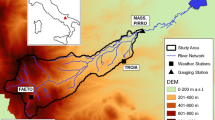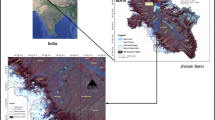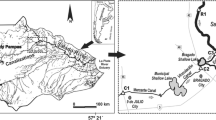Abstract
This study aims to confirm the effect of a small stream impoundment on phosphorus and nitrogen dynamics in a suburban watershed. The results show that the phosphate concentration in the water body was significantly higher than that in the inflowing water under ordinary flow conditions. The phosphorus promotes algal growth that causes significant diurnal dissolved oxygen variation because of photosynthesis and respiration. The phosphate exchange between the sediment and overlying water was mainly controlled by diffusion flux rather than by advective flux seepage because of large amounts of phosphorus accumulated on the surface of the sediment. When a flood occurs, the phosphorus-enriched water is flushed downstream by rain-swollen currents. In summary, an impoundment affects in-stream phosphorus concentration through organic matter degradation and the release of phosphate in the sediment.





Similar content being viewed by others
References
Andersen J (1971) Nitrogen and phosphorus budget and the role of sediments in six shallow Danish lakes. Arch Hydrobiol 74:528–550
Appelo C, Postma D (2006) Geochemistry, groundwater and pollution, 2nd edn. A.A. Balkema Publishers, Rotterdam
Berman T, Béchemin C, Maestrini SY (1999) Release of ammonium and urea from dissolved organic nitrogen in aquatic ecosystems. Aquat Microbial Ecol 16(3):295–302
Bosch NS (2008) The influence of impoundments on riverine nutrient transport: an evaluation using the soil and water assessment tool. J Hydrol 355(1–4):131–147
Boström B, Pettersson K (1982) Different patterns of phosphorus release from lake sediments in laboratory experiments. Hydrobiologia 91:415–429
Boström B, Andersen J, Fleischer S, Jansson M (1988) Exchange of phosphorus across the sediment–water interface. Springer, Dordrecht
Bushaw KL, Zepp RG, Tarr MA, Schulz-Jander D, Bourbonniere RA, Hodson RE, Miller WL, Bronk DA, Moran MA (1996) Photochemical release of biologically available nitrogen from aquatic dissolved organic matter. Nature 381(6581):404–407
Carlton RG, Wetzel RG (1988) Phosphorus flux from lake sediments: effects of epipelic algal oxygen production. Limnol Oceanogr 33:562–570
Chen B, Yang R, Liu Z, Sun H, Yan H, Zeng Q, Zeng S, Zeng C, Zhao M (2017) Coupled control of land uses and aquatic biological processes on the diurnal hydrochemical variations in the five ponds at the shawan karst test site, china: Implications for the carbonate weathering-related carbon sink. Chem Geol 456:58–71
Cook PLM, Aldridge KT, Lamontagne S, Brookes JD (2009) Retention of nitrogen, phosphorus and silicon in a large semi-arid riverine lake system. Biogeochemistry 1–3:49–63
Dodds WK, Jones JR, Welch EB (1998) Suggested classification of stream trophic state: distributions of temperate stream types by chlorophyll, total nitrogen, and phosphorus. Water Res 32(5):1455–1462
Domenico P, Schwartz F (1998) Physical and chemical hydrogeology. Wiley, Hoboken
Editorial Committee of Groundwater handbook (1998) Groundwater handbook revised edition. Kensetsu Sangyo Chosakai, Tokyo. ISBN 4874560350 (in Japanese)
Fujinawa K (2010) Environmental groundwater science. Kyoritsu Publishers Ltd, Tokyo (in Japanese)
Humborg C, Ittekkot V, Cociasu A, Bodungen BV (1997) Effect of Danube River dam on Black Sea biogeochemistry and ecosystem structure. Nature 386(6623):385–388
Jensen HS, Andersen OF (1992) Importance of temperature, nitrate, and pH for phosphate release from aerobic sediments of four shallow, eutrophic lakes. Limnol Oceanogr 37(3):577–589
Johnson LT, Tank JL (2009) Diurnal variations in dissolved organic matter and ammonium uptake in six open-canopy streams. J N Am Benthol Soc 28(3):694–708
Josette G, Leporcq B, Sanchez N, Philippon X (1999) Biogeochemical mass-balances (C, N, P, Si) in three large reservoirs of the Seine Basin (France). Biogeochemistry 47(2):119–146
Kennedy R, Walker W (1993) Reservoirs nutrients dynamics. Wiley, Boston, p 246
Kumar A, ul-Islam S (2019) 6–Inflation and deflation of Rubber Dam. In: Thomas S, Rane AV, Kanny K, Dutta ABTHRD (eds) Plastics design library. William Andrew Publishing, Norwich, pp 67–98
Kuwae T, Kibe E, Nakamura Y (2003) Effect of emersion and immersion on the porewater nutrient dynamics of an intertidal sandflat in Tokyo Bay. Estuar Coast Shelf Sci 57(5):929–940
Lehman EM (2008) Impoundments. In: Fath Brian D (ed) Sven Erik Jørgensen. Encyclopedia of Ecology. Academic Press, Cambridge, pp 1937–1942. https://www.sciencedirect.com/science/article/pii/B9780080454054000586
Lindström E, Bergström A-K (2004) Influence of inlet bacteria on bacterioplankton assemblage composition in lakes of different hydraulic retention time. Limnol Oceanogr 49:125–136
Matthews DA, Effler SW (2006) Assessment of long-term trends in the oxygen resources of a recovering urban lake, onondaga lake, New York. Lake Reserv Manag 22(1):19–32
Mozeto AA, Silvério PF, Soares A (2001) Estimates of benthic fluxes of nutrients across the sediment-water interface (Guarapiranga reservoir, São Paulo, Brazil). Sci Total Environ 266(1–3):135–42
Nakamura Y (1997) Sediment oxygen demand and phosphate release rate : significance of the processes in the Benthic Boundary Layer. Bull Coast Oceanogr 35(1):15–25 (In Japanese)
Nowlin WH, Evarts JL, Vanni MJ (2005) Release rates and potential fates of nitrogen and phosphorus from sediments in a eutrophic reservoir. Freshw Biol 50(2):301–322
Prochnow SJ, White JD (2008) Small reservoir impact on simulated watershed-scale nutrient yield. Res Lett 2007:4
Shimizu Y, Onodera S-I, Saito M, Hirayama Y, Takahashi H (2009) Dissolved nitrogen removal in the ponded streams of an alluvial, suburban basin with a developing city, western Japan. IAHS Publ 330:143–149
Southwell MW, Mead RN, Luquire CM, Barbera A, Avery GB, Kieber RJ, Skrabal SA (2011) Influence of organic matter source and diagenetic state on photochemical release of dissolved organic matter and nutrients from resuspendable estuarine sediments. Mar Chem 126(1):114–119
Sullivan JR Jr (1993) Reconnaissance of water quality of Lake Henry and Lake Meredith Reservoir, Crowley County, Southeastern Colorado, April–October 1987. Water-Res Invest Rep. https://doi.org/10.3133/wri914102, https://pubs.er.usgs.gov/publication/wri914102
Teodoru C, Wehrli B (2005) Retention of sediments and nutrients in the iron gate I reservoir on the Danube River. Biogeochemistry 76(3):539–565
Ukita M, Nakanishi H, Amagai M (1975) Some problems on estimates of benthic fluxes of nitrogen and phosphorus from sediment (I). J Water Waste 17(10):1277–1290 (In Japanese)
Vollenweider R (1969) Möeglichkeiten und Grenzen elementarer modelle der Stoffbilanz von Seen. Arch Hydrobiol 66:1–36
Wang J, Zheng B, Kang X, Yu H, Li D, Jiang X (2019) Diel variation of water inorganic nitrogen and phosphorus during algal blooms. Polish J Environ Stud 28(2):867–875
Wetzel RG (1990) Land-water interfaces: Metabolic and limnological regulators. SIL Proc 1922–2010 24(1):6–24
Wollheim WM, Vörösmarty CJ, Peterson BJ, Seitzinger SP, Hopkinson CS (2006) Relationship between river size and nutrient removal. Geophys Res Lett 33(6):L06410
Wu Y, Wen Y, Zhou J, Wu Y (2014) Phosphorus release from lake sediments: Effects of pH, temperature and dissolved oxygen. KSCE J Civil Eng 18(1):323–329
Xu Z, Xu YJ (2015) Determination of trophic state changes with diel dissolved oxygen: a case study in a Shallow Lake. Water Environ Res 87(11):1970–1979
Zeng S, Liu H, Liu Z, Kaufmann G, Zeng Q, Chen B (2019) Seasonal and diurnal variations in dic, no3- and toc concentrations in spring-pond ecosystems under different land-uses at the shawan karst test site, sw china: Carbon limitation of aquatic photosynthesis. J Hydrol 574:811–821
Acknowledgements
The authors thank Ms. K. Onodera, Mr. Y. Kato, and Mr. K. Onishi for their assistance in chemical analysis and field measurement. This study was supported by the Japan Society for the Promotion of Science Grants-in-Aid for Scientific Research grants (# 18201007 and # 21241011).
Author information
Authors and Affiliations
Corresponding author
Additional information
Publisher's Note
Springer Nature remains neutral with regard to jurisdictional claims in published maps and institutional affiliations.
Handling Editor: Syuhei Ban.
Electronic supplementary material
Below is the link to the electronic supplementary material.
10201_2020_619_MOESM2_ESM.pdf
Supplementary Fig. 2 Nutrient concentration in the sediment profile. The concentration at a depth of 0 cm shows that of the overlying water. Pore water samples could not be collected at depths of 4–15, 17–23, and 32–34 cm. The overlying water concentrations were used as mean concentrations in the lowest position of the vertical profiles shown in Fig. 2 (PDF 32 kb)
10201_2020_619_MOESM3_ESM.pdf
Supplementary Fig. 3 Observed water quality parameters during a flood event on June 29th, 2009. a The water level of the impoundment, b SEC, c\(\hbox {PO}_{4}^{3-}\)ΓÇôP concentration, and d\(\hbox {NO}_{3}^{-}\)ΓÇôN and \(\hbox {NH}_{4}^{+}\hbox {-N}\) were observed hourly during the day. The SEC at the inlet from 12:00 to 14:00 and nutrient concentrations from 10:00 to 16:00 were not observed (PDF 9 kb)
Rights and permissions
About this article
Cite this article
Shimizu, Y., Onodera, Si., Jin, G. et al. Effect of in-stream impoundment on water quality of a suburban stream. Limnology 21, 393–402 (2020). https://doi.org/10.1007/s10201-020-00619-x
Received:
Accepted:
Published:
Issue Date:
DOI: https://doi.org/10.1007/s10201-020-00619-x




